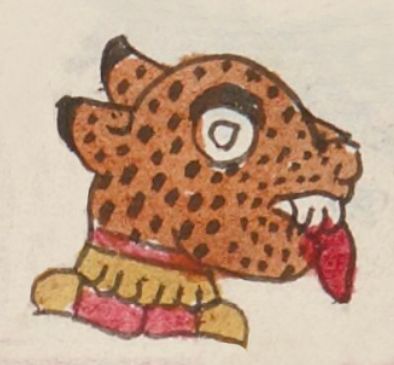ocelotl (TR15v)
This colorful simplex glyph of a jaguar (ocelotl) from the Codex Telleriano-Remensis shows its head in profile and facing toward the viewer's right. Its coat is orange with small black spots. Its ears are short and have a black edging. Its eye is white, wide open, and has a black eyebrow. Its mouth is slightly open, with white teeth showing, and a long red tongue protruding. At the animal's neck is a yellow scalloped edging, as though the head has been severed. Below that appears to be some red and yellow organs exposed. The ocelotl was a day sign in the 260-day divinatory calendar called the tonalpohualli.
Stephanie Wood
Organs, as shown below, typically come in red and yellow. Scalloped yellow edges can suggest a severing, such as can be seen in the severed part of the tree of Tamoanchan (also below). The autonomous-era sculpture of the divine force of Coyolxauhqui, who was cut into many pieces, has these scalloped edges all over it. For more on red and yellow interiors, see the article on the left navigation bar.
Note the iconography of the jaguar in the museum comparison image below. In that stone carving, there are a number of speech scrolls, suggesting that the jaguar is growling.
Stephanie Wood
ca. 1550–1563
Jeff Haskett-Wood and Stephanie Wood
jaguares, calendarios, días, fechas, dates, days, calendars, calendarios
ocelotl. This example of stone sculpture iconography is from the Templo Mayor but is in the collection at the Museo Nacional de Antropología e Historia, Salón Mexica. Photograph by Robert Haskett, 14 February 2023. Note the mouth being open and the teeth showing. What may be speech scrolls surround the jaguar; perhaps it was growling.

ocelo(tl), a jaguar (Felis onca), or an ocelot (Felis pardalis), https://nahuatl.wired-humanities.org/content/ocelotl
el jaguar
Stephanie Wood
Telleriano-Remensis Codex, folio 15 recto, MS Mexicain 385, Gallica digital collection, https://gallica.bnf.fr/ark:/12148/btv1b8458267s/f56.item.zoom
The non-commercial reuse of images from the Bibliothèque nationale de France is free as long as the user is in compliance with the legislation in force and provides the citation: “Source gallica.bnf.fr / Bibliothèque nationale de France” or “Source gallica.bnf.fr / BnF.”




